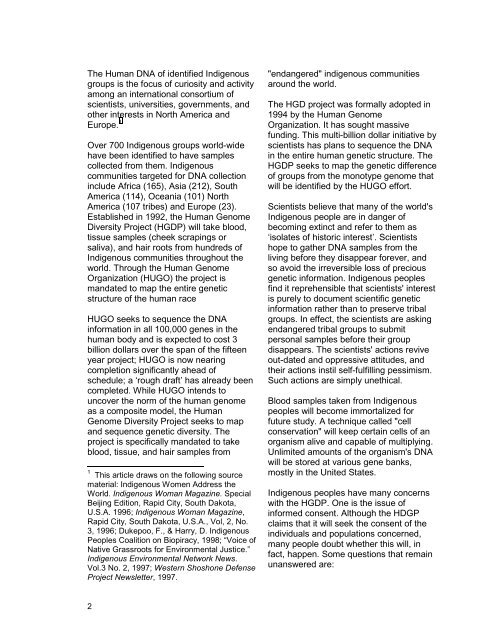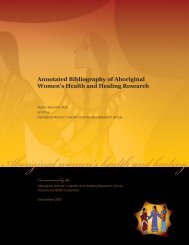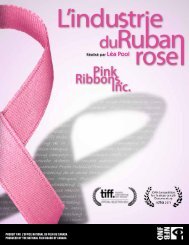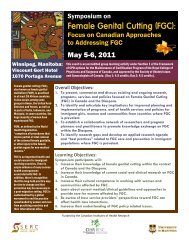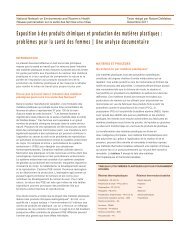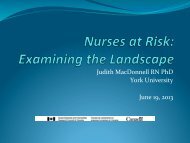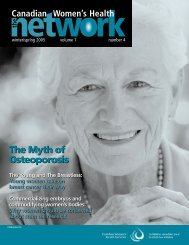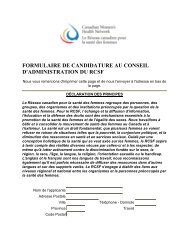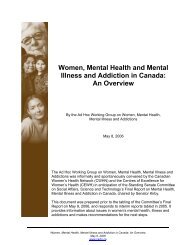from Priscilla Settee - Canadian Women's Health Network
from Priscilla Settee - Canadian Women's Health Network
from Priscilla Settee - Canadian Women's Health Network
- No tags were found...
You also want an ePaper? Increase the reach of your titles
YUMPU automatically turns print PDFs into web optimized ePapers that Google loves.
The Human DNA of identified Indigenousgroups is the focus of curiosity and activityamong an international consortium ofscientists, universities, governments, andother interests in North America andEurope. 1Over 700 Indigenous groups world-widehave been identified to have samplescollected <strong>from</strong> them. Indigenouscommunities targeted for DNA collectioninclude Africa (165), Asia (212), SouthAmerica (114), Oceania (101) NorthAmerica (107 tribes) and Europe (23).Established in 1992, the Human GenomeDiversity Project (HGDP) will take blood,tissue samples (cheek scrapings orsaliva), and hair roots <strong>from</strong> hundreds ofIndigenous communities throughout theworld. Through the Human GenomeOrganization (HUGO) the project ismandated to map the entire geneticstructure of the human raceHUGO seeks to sequence the DNAinformation in all 100,000 genes in thehuman body and is expected to cost 3billion dollars over the span of the fifteenyear project; HUGO is now nearingcompletion significantly ahead ofschedule; a ‘rough draft’ has already beencompleted. While HUGO intends touncover the norm of the human genomeas a composite model, the HumanGenome Diversity Project seeks to mapand sequence genetic diversity. Theproject is specifically mandated to takeblood, tissue, and hair samples <strong>from</strong>1 This article draws on the following sourcematerial: Indigenous Women Address theWorld. Indigenous Woman Magazine. SpecialBeijing Edition, Rapid City, South Dakota,U.S.A. 1996; Indigenous Woman Magazine,Rapid City, South Dakota, U.S.A., Vol, 2, No.3, 1996; Dukepoo, F., & Harry, D. IndigenousPeoples Coalition on Biopiracy, 1998; “Voice ofNative Grassroots for Environmental Justice.”Indigenous Environmental <strong>Network</strong> News.Vol.3 No. 2, 1997; Western Shoshone DefenseProject Newsletter, 1997."endangered" indigenous communitiesaround the world.The HGD project was formally adopted in1994 by the Human GenomeOrganization. It has sought massivefunding. This multi-billion dollar initiative byscientists has plans to sequence the DNAin the entire human genetic structure. TheHGDP seeks to map the genetic differenceof groups <strong>from</strong> the monotype genome thatwill be identified by the HUGO effort.Scientists believe that many of the world'sIndigenous people are in danger ofbecoming extinct and refer to them as‘isolates of historic interest’. Scientistshope to gather DNA samples <strong>from</strong> theliving before they disappear forever, andso avoid the irreversible loss of preciousgenetic information. Indigenous peoplesfind it reprehensible that scientists' interestis purely to document scientific geneticinformation rather than to preserve tribalgroups. In effect, the scientists are askingendangered tribal groups to submitpersonal samples before their groupdisappears. The scientists' actions reviveout-dated and oppressive attitudes, andtheir actions instil self-fulfilling pessimism.Such actions are simply unethical.Blood samples taken <strong>from</strong> Indigenouspeoples will become immortalized forfuture study. A technique called "cellconservation" will keep certain cells of anorganism alive and capable of multiplying.Unlimited amounts of the organism's DNAwill be stored at various gene banks,mostly in the United States.Indigenous peoples have many concernswith the HGDP. One is the issue ofinformed consent. Although the HDGPclaims that it will seek the consent of theindividuals and populations concerned,many people doubt whether this will, infact, happen. Some questions that remainunanswered are:2


